|
Monday, November 3, 2008
Progress Notes
One of the newer items we have placed in the Lee Mace Music Display is an old Vega five string Banjo (photo 01) given me in 1962 by Omer Robinett, of the Brumley\Ulman area (photo 02).
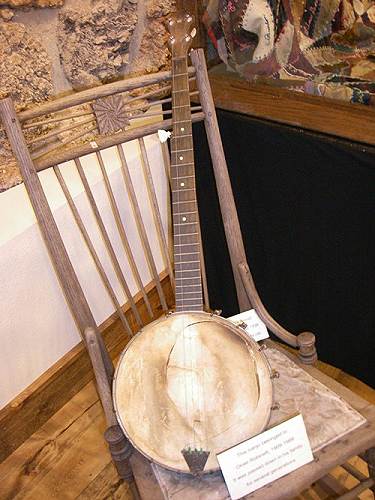
01 Omer Robinett Banjo
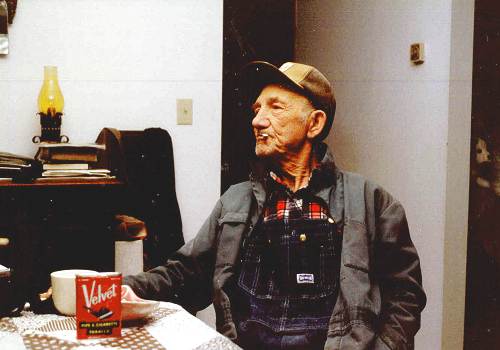
02 Omer Robinett
The banjo had belonged to Omer’s father, Herman, who was an accomplished musician, especially on the fiddle (photo 03).
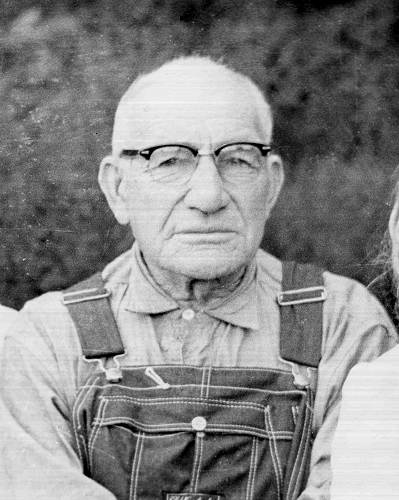
03 Herman Robinett - Father of Omer
I haven’t seen a Vega this old before and I estimate it was built in the early 1900’s. You can read more about the Vega banjo at this website:
https://en.wikipedia.org/wiki/Vega_Company
Omer (who was in his mid fifties in 1962) and I met at Indian Burial Cave where both of us were working as cave guides for Lee Mace, the owner of the tourist oriented cave. The farm where Omer was born and raised was on the Twin Bridges Road near Brumley and was located next to the farm owned by Lucian Mace, Lee’s father. So Omer, being about eighteen years older, had known Lee since he was born. Omer said that often, Lee would come over to listen to his father, Herman, play the fiddle. Omer learned to play the fiddle some but he didn’t pay much attention to the banjo so it was easy for him to give it to me. He didn’t really know just how old the banjo was so a precise date of manufacture isn’t available. I learned to play a few tunes “Scruggs’ Style” on it but later turned to the mandolin as my favorite instrument. I am glad I didn’t sell the old banjo because now it can be placed in our museum as a true Miller County owned musical instrument from the distant past.
After placing the banjo in our Miller County musical display I began to think about the Robinett family, not only just Omer but also his son, Donald, with whom I had gone to school in Tuscumbia. One reason I reminisced about Omer and Donald was that I remembered what a historian Omer had been about the Brumley area of Miller County, and especially what a photographic memory Omer had for the Robinett family history. Omer could recite his family’s genealogical story by memory, including birth and death dates, all the way back to the first Robinetts to arrive in America. This gift of memory possessed by Omer was brought to my attention again a few weeks ago when I received a recording of Omer orally presenting the Robinett family history to some relatives in great detail and totally from memory. So it occurred to me that the Robinett family history would be an interesting topic for this week’s Progress Notes.
Following up on this idea, I called Donald Robinett on the telephone and set up an appointment for us to meet and go over records and photographs Donald possessed of the family. I hadn’t seen Donald since high school so I was really looking forward to our meeting last week. Donald and his wife, Jan, were ready for me having gathered together records and photos for me to scan (photo 04).
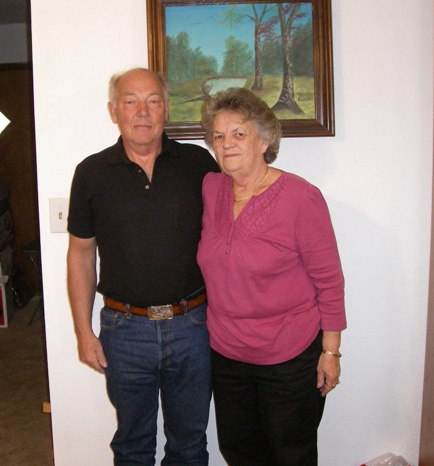
04 Donald and Jan Robinette
The first thing Donald showed me was a very detailed genealogical record of the Robinett family he had gathered together on one large flow sheet (photo 05).
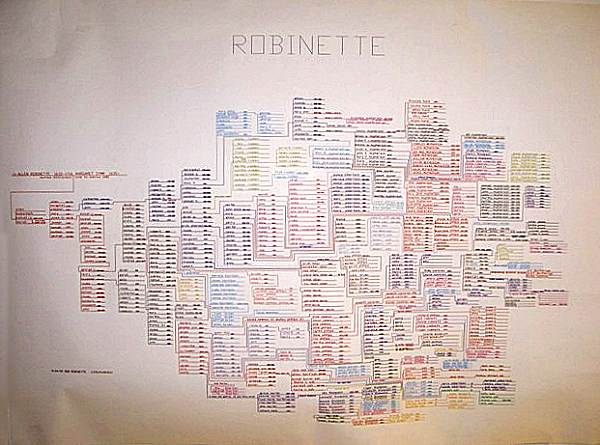
05 Robinette Genealogy Chart
I remarked that I noted he was the only Robinett in the phone book to end his last name with an “e”. Donald said that was the original French spelling of the name but after a couple of centuries in America, the “e” was dropped by most of the Robinett families. But since he had done the research to discover the original spelling he decided to use that spelling for himself. Donald said that the Robinette’s in France were Huguenots who had experienced persecution for their protestant religious beliefs causing them to flee to England and then later to America as part of William Penn’s invitation to Europeans to come to Pennsylvania. So the first Robinette’s came to America on one of Penn’s ships. The area where they settled later became Delaware.
According to Donald his first antecedent in America was Allen Robinette (1638-1718) followed in order by Samuel, James, Samuel, James, George (who was the first to arrive in Miller County in 1854), Hiram, Herman (Donald’s grandfather), Omer and then Donald. One story which has passed down through the family is that Allen Robinette (and they were still keeping the “e” at the end during Allen’s life) was married in St. Mary Aldermanbury Church in London before he migrated to America.
This famous church is the one that was rebuilt in Fulton, Missouri after WWII and is where Winston Churchill gave his famous “Iron Curtain” speech.
You can read more about the church at this website:
https://www.nationalchurchillmuseum.org/church-of-st-mary-history.html
After chatting for awhile at Donald’s home we drove over to the Robinett 1864 Cemetery located on Rodden Church Road (photo 08).
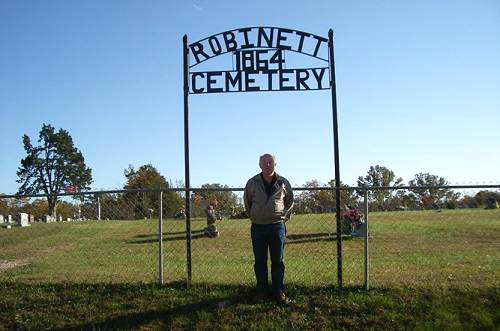
08 Robinett 1864 Cemetery - Donald Robinette
This is where most of Donald’s family is buried except for Hezekiah and his wife and daughter who are buried in Brumley in an area especially designated for them. Hezekiah, a brother of George, came to Miller County a couple of years after George. Here are some of the Robinett family tombstones at the 1864 cemetery:
George (photo 09), Hiram (photo 10), Herman (photo 11) and Omer (photo 12).
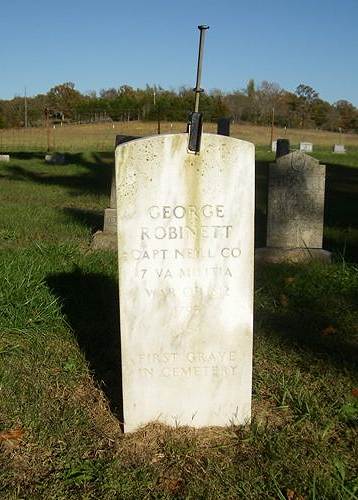
09 George Robinett - 1795-1864 - Fought in 1812 War
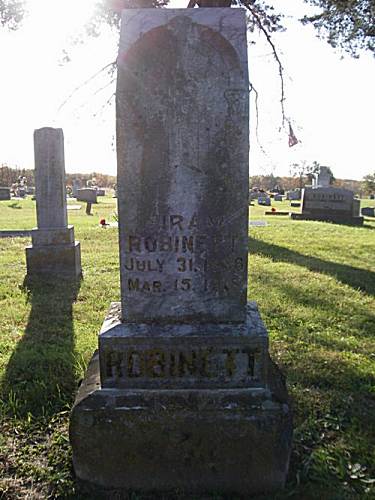
10 Hiram Robinett
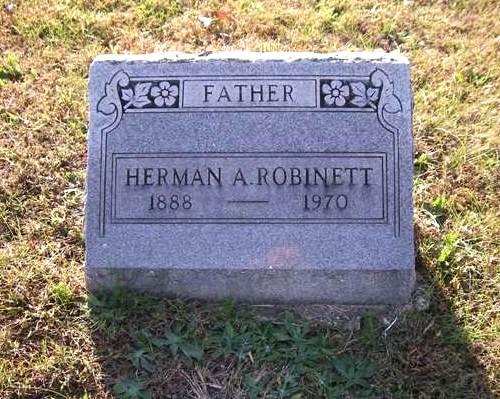
11 Herman Robinett
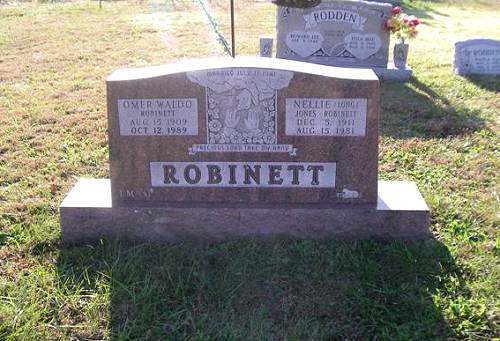
12 Omer Robinett
The cemetery where Hezekiah is buried, named the Robinett Family Cemetery to distinguish it from the larger Robinett 1864 Cemetery, is located just north of the Highway C junction with Highway 42 on the west side of Brumley. It contains three graves. That of Hezekiah (photo 13), his wife Malinda (photo 14) and daughter Mary (photo 15).
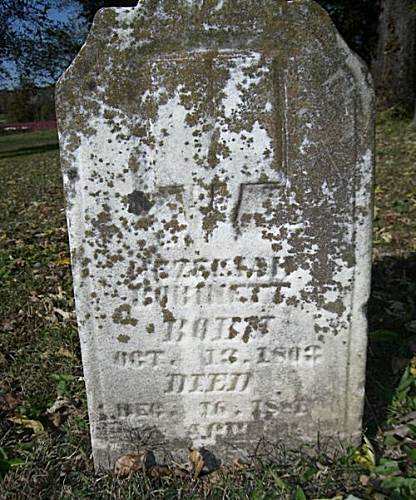
13 Hezekiah Robinett - 1803-1881
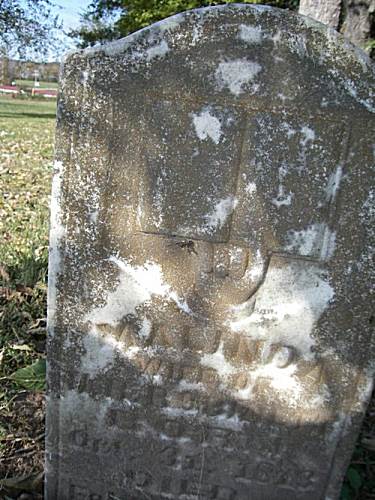
14 Malinda Robinett - 1813-1887
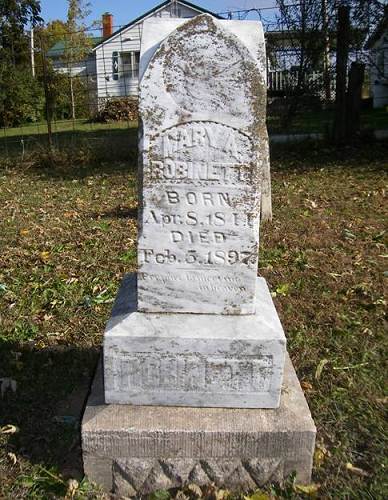
15 Mary Robinett - 1844-1897
Hezekiah, who was Donald’s great great great great uncle, was one of the early settlers of Brumley. Omer Robinett, Donald’s father, wrote a short history of Hezekiah and Brumley for the Miller County Historical Society in 1991, and I have copied it here:
A Little About Brumley
As told to Ruth Porter by Omer Robinett of rural Ulman, Missouri
Published in “Miller County Heritage and Vittles” 1991 Miller County Historical Society
Hezekiah Robinett left Virginia about the age of 50 years with his wife and two boys. He arrived in what is now Brumley, Mo. in 1854 (His brother, George Robinett, was already here. George had come to Miller County in 1852.) Hezekiah settled at the cross roads; one road went to Richland, one to Iberia, one to Tuscumbia and one to Linn Creek.
There was no water to be found in the area, so he used a forked stick for a “divine rod” and dug a well where water was discovered underground. It was behind the present store of Glen Shelton and he built a house just below where the Shelton store now stands. The house had a basement which was the first in Glaize township. The settlers round about said he had book “larnin” so they appointed him Justice of the Peace for Glaize township. His home was used for his court. Across the road from his house was his granary and cow shed. Elections were held inside his cow shed!
Two of his sons, Isaac and Robert, would drive an oxcart to Jefferson City and buy two barrels of whiskey at a time to sell to the settlers. They also went to Linn Creek and bought salt by the barrel, two at a time, as they needed it. When the boys went to Jefferson City to get the whiskey, the salesman would give them a sample. He would fill a glass and hand it to Isaac; he would smell it and hand it to Robert and say, “Tas’ it.” For some reason, it took them about a week to make the trip to and from Jefferson City!”
About this same time, there was Robinett’s Wagon Shop approximately a half mile down the crick, later known as the Roy Plemmons farm. In this shop they made linch-pin wagons constructed entirely of wood. They soaked the hubs with homemade soap to keep them from screeching. They also made ox carts, spinning wheels, looms ox shoes, bull tongue plows, and a few cord beds.
About 1858, Hogue and Albertson built a French flint burr to grind corn meal and flour, which is a regular old water mill (stone burr). It was below what is now known as Dick’s Cabins. The Civil War broke out in 1860 and Hogue had to go to the army. He was killed about 1863. Albertson and Hogue’s wife continued to run the mill until about 1910.
The Brumley community at that time was called “Old Virginia” because so many people had come here from that state before the Civil War. After the war, it was called Gingerbread or Gingerbread township.
About 1875, Jim Thompson built a store and started a general mercantile business. At this same time, a Mr. Brumley had a post office about 3 miles south of what is the town of Brumley today. Later they moved the post office to Thompson’s store and officially named it Brumley. About 1877, Doctor Conner came to Brumley and started a practice.
Clark Martin moved from Iberia and built a livery stable and hotel in the young town and, in 1880, the first public school was built in front of what is now the Baptist church. A roller mill was formed and built just below Brumley on Jake Branch, and it is still standing. It was powered by steam. Ruth Plemmons Porter’s grandmother Plemmons was a share holder in this roller mill.
In 1896, the Bank of Brumley was established (photo 16).
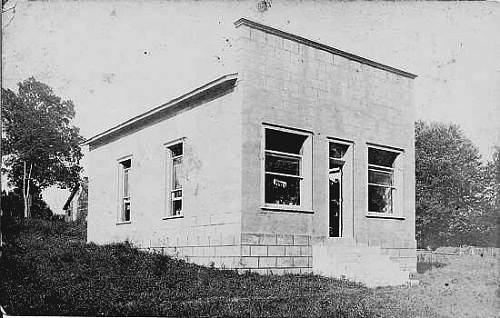
16 Bank of Brumley
Early Plemmons, father of Ruth, for many years owned and operated a grocer store in Brumley and he also bought fur. Crockett and George Wall, brothers, had a store in Brumley for a number of years also.
Hezekiah Robinett, the early pioneer of Brumley, is buried in the town as well as his wife, Malinda and a daughter, Mary. These stones are located north of the Highway C and Highway 42 junction (As noted above).
Donald told me that he and his father Omer, were the first farmers in Miller County to sign a contract with Cargill Company to build one of the large confinement buildings for concentrated swine production in 1985 (photo 17).
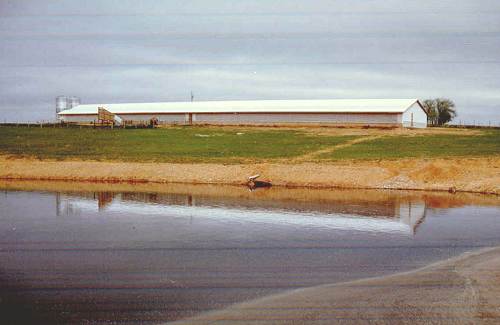
17 Confinement Barn
They received quite a bit of publicity then from the Cargill Company itself (photo 18) as well as a write up in the farm journal, “Successful Farmer.”
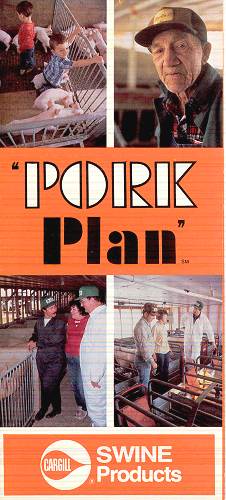
18 Cargill Brochure
Donald took me for a tour of the several farms he now owns in the area off Route JJ near Ulman. A particularly interesting stop we made was the “old homeplace” where Donald was raised. Donald is one of the few remaining people of my generation to have been raised in an original log house. This house is still standing miraculously well preserved; I took a picture of Donald standing in front of his old log home (photo 19).
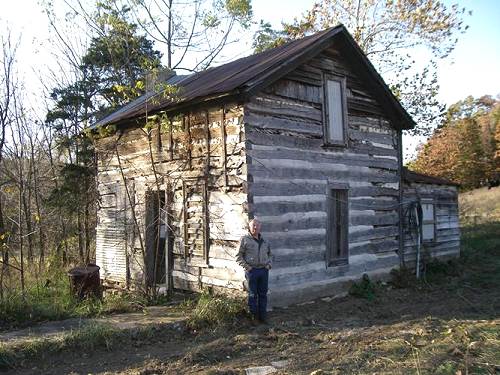
19 Donald Robinette in front of Boyhood Home
Donald told me the log home was constructed before the Civil War and that the plaster on the walls inside the main room still is preserved having been put there during the Civil War (photo 20).
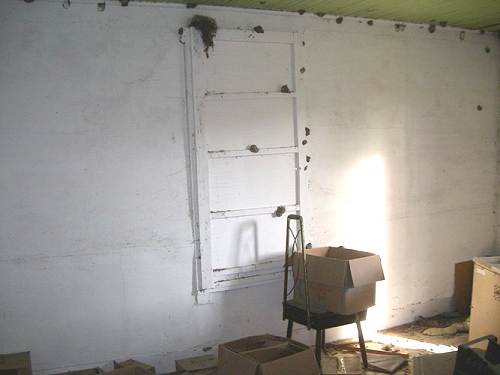
20 Plaster on walls dates from Civil War
This must be one of the oldest homes in Miller County. Donald said that he was told the original home owner was a family named Sullivan. His father, Omer, purchased the farm and home from Pal Nixdorf in the early 1940’s.
Nearby is located an area which at one time was a source of “crystallized limestone” which Donald said was used for the construction of many buildings in Miller County in the late 1800’s and early 1900’s including the Miller County Courthouse (photo 21) as well as the Dog Creek School house located nearby (photo 22) now housing Bethel Missionary Baptist Church.
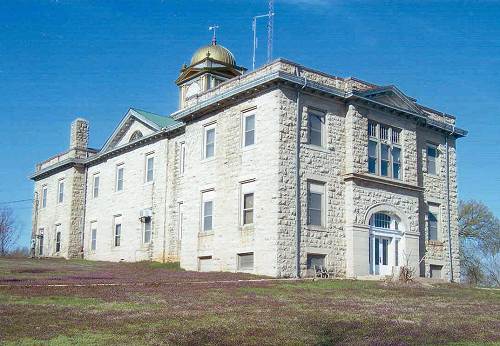
21 Old Courthouse - 2008
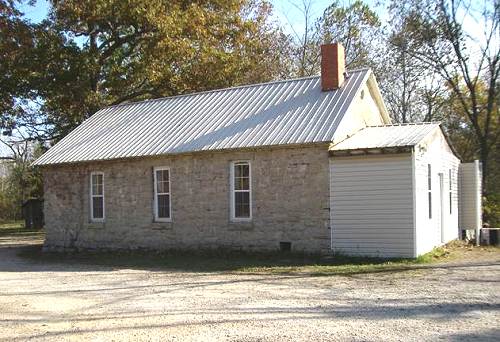
22 Dog Creek School
Donald had used some of these stones left from the mine for foundation work for structures on his farm. Here is a photo of some of these stones (photo 23).
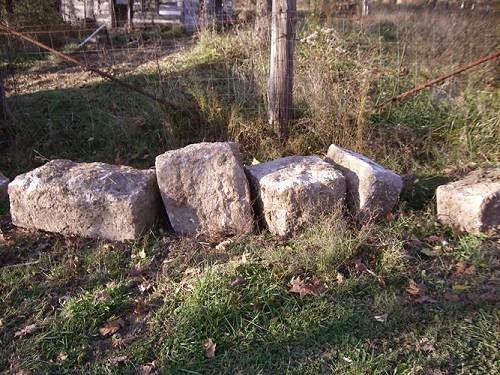
23 Crystalized Limestone
Carolyn (Patterson) Pryor was a neighbor of the Robinett family whose farm adjoined that of the Robinsons’. She wrote an interesting essay about her memories of her life when she was a childhood neighbor of Donald and his family:
I was thinking about where Donald lived as we had to pass it every day going to and from school and we played together all our young lives, especially my brother Harold and Donald and several of my other nine brothers who might still have been at home then. They also played with Donald’s half brothers, Robert and Gene Jones.
Nellie, Donald’s mother, was married prior to Bob (Omer). Her first husband had burned to death in a fire and it seems like I can recall her having burn scars, but I could be wrong on this. Nellie, was such an integral part of our lives...she was our Sunday school teacher at the Bethel Baptist church and so very good to us. During the week all of us kids walked to the Dog Creek School where I and Harold went until our 3rd grade year when all the country schools in that area consolidated with School of the Osage. Later, however, both of us decided to finish our high school education at Tuscumbia.
Nellie, mother of Donald, was to me a woman before her time in our area...she had long, very pretty naturally curly hair, wore flowers in her hair pulled up on one side and she also wore make up, even red lipstick. She sewed herself bright colored clothing and even wore some jewelry. She was pretty feisty, an exact opposite of my Mom and most of the others around where we grew up. I was very fascinated by her because she did not have an easy life, just as didn’t all the others around there, but she was always happy. She loved to jig dance and many frowned on that during those times; but she was very religious too. I can tell you, she meant the world to me. One reason she doted on me so much was, I felt, because she never had any girls, all boys, and she would fix my hair and fiddle with me all the time because of that. They had a spring just up the creek a little ways from their house and she would let me help her take and get things out of the spring and that was a big treat as we did not have one.
There was a big spring just down the road by the Dog Creek school house and Mom would pack us pints jars of milk in our lunch and drop it off in the spring at the school until lunch time. I did save one letter Nellie had written to me thanking me for some money I sent her for an old milk can she sold me. This was in the 70's when it was the in thing to paint them in the antiquing style and I sat it outside with a flower in it.
Speaking of flowers, Nellie always planted loads of flowers along her garden sides and I can still just see the rows of vivid red velvet Cockscombs. She always had loads of four o'clocks and would share her seeds with Mom. Our Dad was pretty good with shears and did the neighbors’ sheep shearing and one of them was Donald's dad, Bob (Omer), with his sheep, always a big ordeal. I think they had goats too, but we never did. One of Bob's (Omer’s) brothers was a doctor in Kansas City (Dr. Wade Robinett, ENT specialist).
In our area there were quite a few older homes that were log homes built when the farms were homesteaded and then later the owners added on to them framed additional rooms.
It's hard to realize, but many, actually most of us existed on nothing that involved money at all. We did have plenty of food and good, loving homes with loads of attention and I can't see it hurt any of us one bit, probably if anything made us better people.
So what started out as a little bit of history regarding the old banjo given me by Omer Robinett turned out to be a really interesting story of the entire Robinett family, certainly one of the pioneer families of Miller County and in particular of the town of Brumley.
Last week I wrote about Rex Wyrick, one of Miller County’s State Representatives. In the narrative I included a photo of a group of people which included a woman named Norma Jones (photo 24).
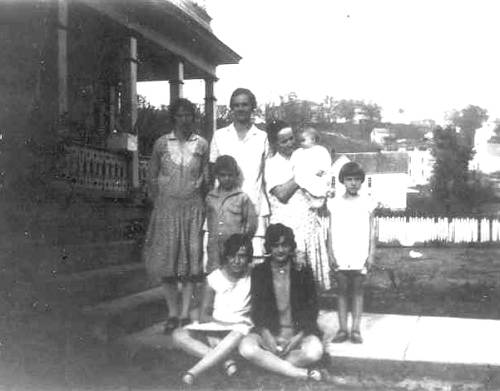
24 First Row Seated: Inez Johnson and Inez Wyrick
Second Row Standing: Rex Wyrick and Susie Bear
Third Row: Norma Jones, Gertie Wyrick, Mother Sadie Bear and Bonnie Bear
She was a niece of Rex Wyrick’s mother Gertie, the daughter of Dora Olive "Ollie" Sullivan and William M. Jones. Norma (photo 25) stayed in Tuscumbia quite a bit during those days as she was a patient of Dr. T.F. Thomson, a Chiropractor.
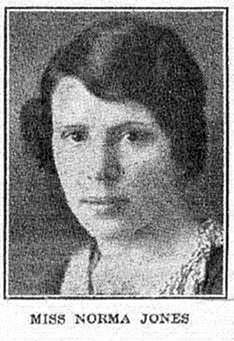
25 Norma Jones
Dr.Thomson, who had moved into Tuscumbia back in the 1920’s, was best known for being able to cure hiccups. Before he built his own house, Dr. Thomson had rented a room from my grandparents (Madison and Sadie Bear) in the old Phil Hauenstein House. My mother remembers that one of Dr. Thomson’s patients was Norma Jones. Mom said Norma visited Dr. Thomson everyday for a treatment which kept her from hiccupping the rest of the day. Otherwise it was said that she hiccupped constantly all day long.
Karen Wyrick, daughter of Rex Wyrick, and cousin of Norma Jones, sent me an article printed in the Autogram that told more about the story of her cousin and Dr. Thomson.
Hiccoughs Thirty One Months
Medical and hospital treatment failed to correct this patient’s condition. Because of Chiropractic, she is now strong and healthy. Read this woman’s statement.
February 6, 1933
For over four years Miss Norma Jones, of Osage City, Missouri, has suffered one misfortune after another with a heroic smile, but wept when the hiccoughs finally stopped.
Her care has baffled the medical profession for three years. She was known as the mystery patient and probably the longest case of continuous hiccoughing on record. Dr. T. F. Thomson was able to stop the hiccoughs by Chiropractic adjustments. Miss Jones states her story as follows:
Osage City Mo. January 3, 1933
To Whom It May Concern:
Not many months ago friends, doctors and relatives had given up hope of my recovery, or even of my continued existence on this fair old earth of ours. For, as many know, I have suffered long with many ills. My troubles began some four years ago when an unfortunate fall caused a complete collapse of my nerves. The terrific shock to my entire system inhibited the proper functioning of all organs. As an immediate result severe headaches started, but they proved a mere beginning of more trouble. My stomach became sour…for this I was placed on a strict milk diet and told by my medical advisors to take a complete rest. At times large puffed places appeared on my back and on my ankles…for this adhesive bandages were applied.
After some time, during which my condition became worse, I was removed to the hospital. I was unable to take any food other than milk and to this it became necessary to add lime water that I might retain it, for vomiting and hemorrhaging had now become a daily occurrence. At the hospital X-ray pictures were made and my trouble was diagnosed as nervous gastric ulcers of the stomach. Along with this announcement came the information that the stomach had fallen to the pelvic bones, the liver was sluggish and very much enlarged, and the gall bladder was causing trouble. Through the use of the fluoroscope the doctors were able to see that the outlet of the stomach was closed. Only by pressing with the hands could food be made to pass through. Different applications, including electrical treatments, were given, but all of them failed to bring about the desired results. Each day I suffered endless agony.
However, at the end of four weeks time I was returned home seemingly somewhat improved, for seven and one half months living on a milk diet. Finally, I was again taken to the hospital, this time for an operation, the only remaining effort to be made. Since the hemorrhaging had not been eliminated, it was thought best to wait before operating.
After two weeks I was stricken with hiccoughs, caused, the doctors said, by the ulcers. The first attack which lasted about two hours, completely exhausted my strength and left me in an unconscious state, when finally relief came through the use of morphine. From this time on I had hiccoughs every day as soon as I awakened and often an attack came upon me as I slept, making it necessary to awaken me. The doctors feared that the constant jerking of the stomach might break the ulcers, causing more trouble (if such could be), since I was still vomiting and hemorrhaging.
For four weeks I lay in this condition, unable to sleep or to take much nourishment. Several doctors were consulted and a series of electrical treatments, medicines, mustard plasters, camphor-ethyl chloride, ice packs, hot packs, home remedies and chloroform, intravenous shots administered, but relief was obtained only through the use of morphine, and then only temporarily. I hiccoughed ninety five times a minute, attacks lasting from thirty minutes to six hours. Twice during this time morphine failed to relieve the spasm and once I was chloroformed nine times during one day.
At the end of nine weeks an operation was again advised, but all my strength was gone. Preparations had been made for the operation by a St. Louis specialist, but a consulting specialist advised against it, fearing I might die on the table. This doctor placed me under a new treatment. For six days I was fed through the bowels and the veins. The hiccoughs continued, but the hemorrhages were somewhat lessened. For five weeks I was forced to lie flat on my back, at times not daring to move at all.
After fifteen weeks I was removed to my home. I weighed ninety pounds and was unable to sit alone, but I felt that I was some better. The hiccoughs and hemorrhages continued, however, and there were times when I was unable to take food for several days. I endured the intravenous shots and treatments still being given, but became worse. The hiccoughs began to follow each other more rapidly, finally causing the heart muscles to be torn so that there was no resistance. This led to a bad condition of the circulatory system, making my body seem paralyzed. It was again decided to take me to the hospital, but a bad vomiting spell so weakened me that it was impossible to move me. I had no pulse and the attending physician said that I was dying, but I rallied to withstand that attack.
My worried father, having heard that Dr.T.F. Thomson, a chiropractor from Kentucky, was vacationing not far away, decided as a final measure to consult him. Dr. Thomson accepted my case and immediately adjusted my spine, which temporarily stopped the hiccoughs. The adjustments were continued and in a month’s time, on September 27, 1932, the hiccoughs stopped once and for all. I began to improve in every way. I have gained eighteen pounds; I no longer suffer with constipation; my color has become clear. My diet list has so broadened that I may now eat almost any food.
Everyday I meet friends who are as surprised and happy as I that I live and walk when it seemed so certain that this could never be. I owe my life to the skilled work of Dr. Thomson, who is now located in Missouri with offices at Tuscumbia.
I am so grateful I feel that the portals of a new world have been opened to me and hope this may be the means of someone else getting relief
(Signed) Norma Jones
Subscribed and sworn to before me a notary public in and for the County of Miller, State of Missouri, this 6th day of February, 1932. (Seal)
Byron H. Hix
Notary Public
Commission expires April 10th, 1936.
According to my mother, in whose house Dr. Thomson rented a room and office, Dr. Thomson once resuscitated her younger sister, Bonnie Bear when she got choked. He had a lot of charisma she said and had many patients including my grandmother who suffered Parkinson’s Disease. He later moved out of Tuscumbia, mom thinks probably to Meta. She never saw him again.
The fall colors aren’t so vibrant this year, maybe because of a spell of dry weather at the end of summer. However, the maple trees seem to be as colorful as ever. I found this tree at the front of the Pryor Novelty building in Tuscumbia this week (photo 26):
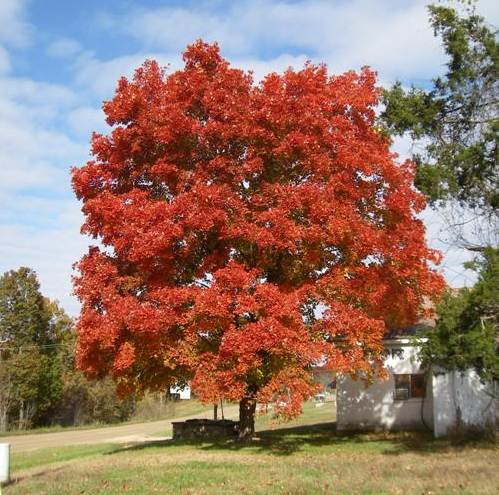
26 Maple Tree at Pryor Novelty Tuscumbia
That's all for this week.
|



